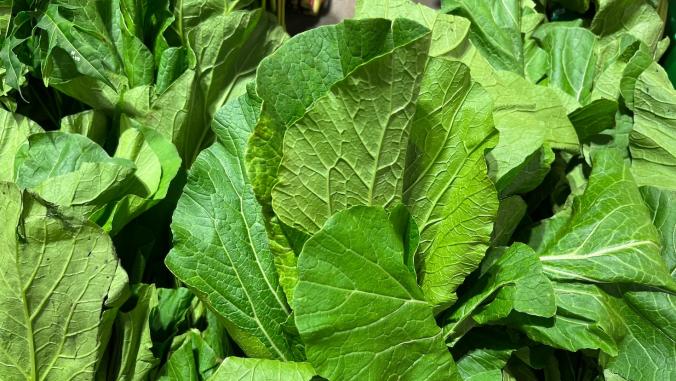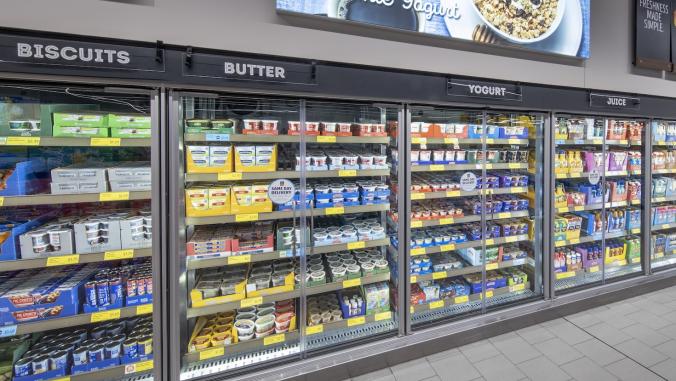GreenBiz’s VERGE 22 in October at the San Jose Convention Center will be my first in-person VERGE event. But when I visited the site for the first time last week, I entered through the loading dock. I walked through bare concrete hallways, industrial double doors and winding corridors that all looked the same except for the odd posters describing a healthy work environment or guidelines for COVID-19 precautions. This was behind the scenes of VERGE and the convention center, not the pomp and circumstance that will greet me when I enter from the other side in a few weeks.
After navigating through the hallways, I arrived at the large, loud and mostly empty kitchen. The hood fans over the stoves hummed like white noise machines whose volume had been turned up a bit too much. My escort, a convention center employee, stopped her introductions when a trolley rolled past, clanking on each of the kitchen’s grouted tiles because it was too loud to talk over.
I was here a month before VERGE 22 to observe a plant-based recipe training for the chefs of the convention center who will be catering the event’s meals. While the staff at the convention center said requests for vegan items aren’t uncommon, it still wasn’t business as usual for them.
"We have never done a full vegan menu," said Duy Tran, executive sous chef at the San Jose Convention Center. "But during our receptions, we always have two or three vegan menu items. [VERGE 22] has a lot more vegan options than usual."
The VERGE conference team aims to offer a plant-rich menu that is low-carbon while still delicious and nutritious; GreenBiz events stopped serving red meat in 2016. As a leader in connecting sustainability professionals and accelerating the transition to a clean economy, GreenBiz events try to "walk the talk." According to a 2014 study from the University of Oxford, vegan diets average half the carbon footprint of meat-based diets. Switching to plant-rich meals at our events is one of our tools for reducing our planetary impact.
We run many other sustainability initiatives behind the scenes at VERGE and other GreenBiz events. They include running a waste diversion program with TerraCycle to recycle things that are not accepted at typical recycling centers; partnering with South Pole to buy high-quality carbon credits to offset the travel of all staff and attendees; tree planting in a wildfire scar in Siskiyou County, California, with One Tree Planted and running VERGE off a 100 percent renewable microgrid.
On the food side, the menu at VERGE 22 will include include vegan and vegetarian options such as butternut squash soup, vegetarian chili, herb and goat cheese filo cups and a vegan pasta primavera alongside more traditional offerings such as turmeric chicken skewers and scrambled eggs with turkey bacon. Beyond just shifting to a plant-rich menu, GreenBiz collaborates with the Convention Center and Copia to distribute any leftover food to nonprofits in San Jose. All of the main meals will be served on reusable plates and cutlery, while some concession items will be served in vessels that are recyclable or compostable with the help of TerraCycle.

Dustin Harder shows the recipe to a San Jose Convention Center chef. Image by Jesse Klein.
At GreenBiz 22 in February, the menu went full vegetarian with many vegan options. But it wasn’t easy to serve a plant-rich menu for a 1,500-person event that was satisfying, delicious and respected a range of dietary needs. We’ve found that food service teams aren’t always trained in plant-based cooking and don’t experience strong demand for this from their other groups. In addition, our venues have been extremely understaffed and under-resourced coming out of the pandemic, further complicating their ability to serve nontraditional menu options. As a result, the food wasn’t on par with what attendees had experienced at the conference in prior years.
"With the return to in-person events following GreenBiz 22, we focused on developing a food strategy that balances sustainability and inclusivity for our attendees’ dietary needs and preferences, rather than completely eliminating meat in the way that we did for GreenBiz 22," said Ellie Buechner, senior vice president of conferences at GreenBiz. "We also started the planning process with the Convention Center much earlier, sharing our goals with the culinary team, learning about the practices they already had in place and planning this plant-based training with venue staff well ahead of the event."
GreenBiz also reintroduced a small proportion of poultry and fish to be more inclusive with our meals. These items are served at the end of buffets in small portions in an effort to encourage attendees to compose plates primarily of vegetarian and vegan options as well as reduce food waste for animal proteins.
Our first attempt at providing such a training was in collaboration with the Physicians Committee for Responsible Medicine (PCRM), a nonprofit that helps to implement plant-based options in the menus for institutions such as universities, prisons and hospitals.
PCRM’s culinary expert, Dustin Harder, led the training in San Jose. In a newsboy hat and with the energy of someone with a background in theater (his words, not mine), he addressed the collected group of a dozen convention center kitchen supervisors, managers, cooks and chefs gathered before him.
"You all know how to cook," he said. "I’m not teaching you how to cook. But these are going to be some interesting recipes."
Harder presented four vegan recipes at this training — mini barbeque jackfruit tacos, Impossible ground beef nachos, sweet and sour Impossible meatballs and a roasted tomato, spinach and artichoke flatbread — some of which will be on the VERGE menu. The goal of this training was to get the chefs comfortable with vegan ingredients they may not be using regularly. Cooking plant-based isn't just about omitting meat; there are techniques, ingredients and preparations that are unique to making vegan food taste creamy, umami and hearty.
For these recipes, that meant working with jackfruit, Impossible meat products and nutritional yeast, and using white beans, cauliflower and carrots as the base ingredients for vegan versions of sour "cream" and a "cheese" sauce for the nachos. Harder’s goal was to show the culinary team that food they know how to cook can be just as easy to make and just as tasty using plant-based ingredients.
I didn’t know that carrot could substitute for cheese sauce. It really hyped me up for cooking. It’s something new.
"The mission is to plant the seed," he told me in an interview after the training. "To expose people who maybe haven’t tried [plant-based foods] at all, and get them cooking and tasting so maybe they’ll try it at home or maybe a menu item finds a permanent spot on that menu."
The cooks split into teams of two, and Harder walked around tasting and conferring with chefs. He corrected one team to mix the spinach and artichokes into the bean spread for the roasted tomato flatbreads instead of putting them on last, as they would if they were treated as toppings. He assured the team making the carrot and cauliflower "cheese" sauce that it doesn’t taste like cheese on its own, but once it’s combined with the rest of the nacho ingredients, it creates a similar effect.
"I didn’t know that carrot could substitute for cheese sauce," Tran said. "The color really caught my eye, and the recipe had the consistency of a cheese sauce and it tasted almost like cheese. I was surprised that the sunflower seeds can be subbed for sour cream. It really hyped me up for cooking. It’s something new."
The four vegan menu items with enough to feed at least 30 people were cooked, plated and ready for lunch in an hour. The speed and efficiency of the cooks were incredible, and I’m extremely jealous of their knife skills. Everyone started digging in.

A chef cuts a vegan pizza. Image by Jesse Klein.
Nora Andrade, a cook supervisor, had never worked with or tasted the Impossible meat products that were part of the nachos and meatballs. "You can’t really taste that it's not actual meat," she said. "And you can’t even tell the difference from the way it’s cooked too."
Amazing vegan restaurants are all over the United States. The San Francisco Bay Area alone is home to dozens, including the vegan sushi restaurant Shizen, which has gained recognition from the Michelin Guide. These vegan options are some of the best food you can get, with or without meat. But it takes a unique set of skills to cook vegan food — to make carrots and sunflower seeds taste like rich, creamy dairy. Plant-based food at scale — served at places such as hospitals, universities and large venues — is still lagging in quality and taste, partly because vegan training for chefs and other culinary experts is not yet mainstream.
"We’ve never had this," Andrade said. "Where the chef cares enough to bring somebody to teach us how it’s done. And to explain the background of it."
Trainings from experts such as Harder should help ensure plant-based food emerging from all types of kitchens doesn’t feel like a second-tier option.






